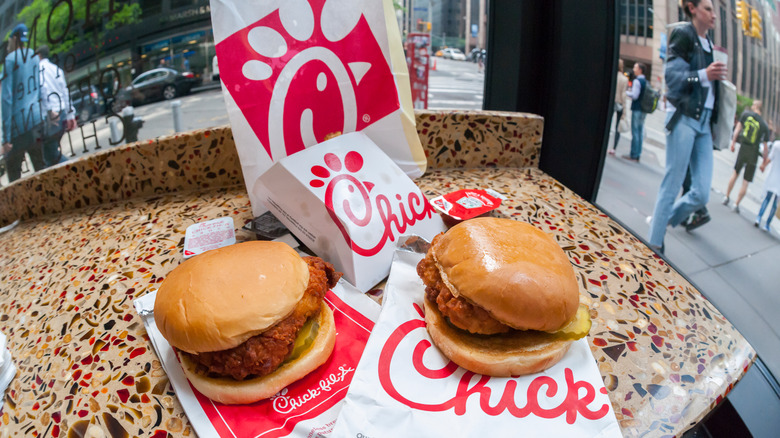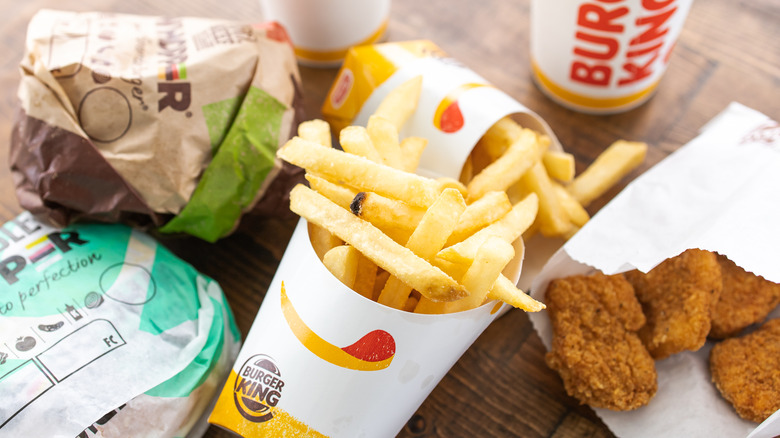Study Says These Fast Food Chains' Packaging Still Contains A Potentially Dangerous Chemical
Many people who love McDonald's french fries might start loving them less if they found out how harmful they can potentially be. We're not talking about the potential health issues associated with eating fried food, which Nourish by WedMD outlines, but the packaging that they come in.
A recent test by Consumer Reports on more than 100 food packaging products, including McDonald's fry bags, cookie and sandwich wrappers and containers, and many more, concludes that they contain "dangerous" chemicals known as per- and polyfluoroalkyl substances, or PFAS. The substances, which some people call "forever chemicals," are also found in nonstick pans, waterproof gear, and the greaseproof boxes that are often used for restaurant takeout.
On the surface these types of packages could look like a blessing for the environment because they aren't plastic or styrofoam, but in some ways many experts consider them to be far worse. That's because PFAS is a "practically unbreakable compound," Consumer Reports notes, which can contaminate soil and water when the packaging ends up in landfills, and the air when it is incinerated.
Where PFAS are found and the problems they can cause
According to Consumer Reports, research links PFAS to many health problems, including immune system suppression, lower birth weight, and higher risk for some cancers. Despite that, The Washington Post reports that the U.S. Food and Drug Administration "has not issued any guidance or set limits for the chemicals in food packaging," even though Swiss environmental engineer Justin Boucher tells Consumer Reports that "we know that these substances migrate into food you eat."
Currently, in addition to McDonald's, Consumer Reports notes that food packaging at Burger King, Arby's, Nathan's, and Chick-fil-A contain PFAS. The publication reports that measurable levels of the substance was even detected in packaging from Trader Joe's and Cava.
Some of this can be unintentional because PFAS is so commonly used. Consumer Reports says it is even found "in ink on food containers, recycled paper, [and] machines that make packaging," and that it might be contaminating products without food manufacturers knowing about it. It is so pervasive that another study conducted by the Centers for Disease Control and reported by the National Institute of Environmental Health Sciences said PFAS can be found in 97% of Americans.
Some big food companies are eliminating PFAS
Some big food companies have said they will minimize or eliminate the use of PFAS in packaging altogether. An Arby's spokesperson told The Washington Post that the chain is "on track to have all PFAS removed from packaging products by the end of this year." Nathan's has reportedly executed a packaging redesign with the intent to "partially reduce PFAS." Chick-fil-A, according to the report, has "eliminated intentionally added PFAS from all newly produced packaging." Burger King has set a hard out for PFAS use "by the end of 2025 or sooner," the newspaper reports.
In the meantime, some states appear to have taken matters into their own hands. JDSupra reports that California, New York, Maine, Vermont, Washington, Connecticut, and Minnesota have passed laws banning PFAS in food packaging. New York's ban takes effect the earliest — that's scheduled to happen at the end of 2022 — while California's ban takes effect on January 1, 2023. At the federal level, the outlet reports that the FDA has a deal for PFAS manufacturers to "voluntarily" end use of certain types of the chemicals by January 2024.
While you're waiting for all that to happen, Consumer Reports says you can mitigate your PFAS exposure by putting your takeout into another container as quickly as possible, and to avoid reheating food in the packaging it came in.


